Not much to say…the main event is what I noticed earlier this afternoon. More of a “record keeping” update than anything else. Did a water change with full strength saltwater again this evening. Dosed with Maracyn SW – this is probably the last does. I have NOT moved her to the 10 gallon “recovery tank” yet. It is my opinion that the water change kinda “pissed her off”.
The Lightning Maroon is doing his thing…more or less acting like he’s not 100% happy with his new smaller living arrangements. The “Labrador” Maroon is my new best friend because FINALLY, I’ve found a clownfish that is able to intimidate the male Pygmy Angelfish (Centropyge argi) that lives in that tank. Suprisingly, the Fire Clowns (Amphiprion ephippium) fought that battle, and I thought they’d won it, but within a few days it was clear the Centropyge were on top. NO LONGER….and the most interesting part is that the male Pygmy doesn’t even try.
- About The Lightning Project
- Inventory of F1 PNG Lightning and White Stripe Maroon Clownfish
- F1 PNG Lightning Maroon Clownfish, BZLM1
- F1 PNG Lightning Maroon Clownfish, BZLM2
- F1 PNG Lightning Maroon Clownfish, FW1
- F1 PNG Lightning Maroon Clownfish, LM10
- F1 PNG Lightning Maroon Clownfish, LM11
- F1 PNG Lightning Maroon Clownfish, LM12
- F1 PNG Lightning Maroon Clownfish, LM13
- F1 PNG Lightning Maroon Clownfish, LM14
- F1 PNG Lightning Maroon Clownfish, LM15
- F1 PNG Lightning Maroon Clownfish, LM16
- F1 PNG Lightning Maroon Clownfish, LM17
- F1 PNG Lightning Maroon Clownfish, LM18
- F1 PNG Lightning Maroon Clownfish, LM19
- F1 PNG Lightning Maroon Clownfish, LM20
- F1 PNG Lightning Maroon Clownfish, LM3
- F1 PNG Lightning Maroon Clownfish, LM4
- F1 PNG Lightning Maroon Clownfish, LM5
- F1 PNG Lightning Maroon Clownfish, LM6
- F1 PNG Lightning Maroon Clownfish, LM7
- F1 PNG Lightning Maroon Clownfish, LM8
- F1 PNG Lightning Maroon Clownfish, LM9
- F1 PNG Lightning Maroon Clownfish, MD1
- F1 PNG Lightning Maroon Clownfish, MWP3
- F1 PNG Lightning Maroon Clownfish, WS17
- F1 PNG Lightning Maroon, EC1
- F1 PNG Lightning Maroon, GL1
- F1 PNG White Stripe Maroon Clownfish, BZWS1
- F1 PNG White Stripe Maroon Clownfish, BZWS2
- F1 PNG White Stripe Maroon Clownfish, BZWS3
- F1 PNG White Stripe Maroon Clownfish, WS10
- F1 PNG White Stripe Maroon Clownfish, WS11
- F1 PNG White Stripe Maroon Clownfish, WS12
- F1 PNG White Stripe Maroon Clownfish, WS13
- F1 PNG White Stripe Maroon Clownfish, WS14
- F1 PNG White Stripe Maroon Clownfish, WS15
- F1 PNG White Stripe Maroon Clownfish, WS16
- F1 PNG White Stripe Maroon Clownfish, WS4
- F1 PNG White Stripe Maroon Clownfish, WS5
- F1 PNG White Stripe Maroon Clownfish, WS6
- F1 PNG White Stripe Maroon Clownfish, WS7
- F1 PNG White Stripe Maroon Clownfish, WS8
- F1 PNG White Stripe Maroon Clownfish, WS9
- F1 PNG White Stripe Maroon, EC2
- F1 PNG White Stripe Maroon, FW2
- F1 PNG White Stripe Maroon, GL2
- F1 PNG White Stripe Maroon, MD2
- Lightning Breeding Directive
- Lightning Maroon Clownfish Links
- Home
- About The Lightning Project
- Inventory of F1 PNG Lightning and White Stripe Maroon Clownfish
- F1 PNG Lightning Maroon Clownfish, BZLM1
- F1 PNG Lightning Maroon Clownfish, BZLM2
- F1 PNG Lightning Maroon Clownfish, FW1
- F1 PNG Lightning Maroon Clownfish, LM10
- F1 PNG Lightning Maroon Clownfish, LM11
- F1 PNG Lightning Maroon Clownfish, LM12
- F1 PNG Lightning Maroon Clownfish, LM13
- F1 PNG Lightning Maroon Clownfish, LM14
- F1 PNG Lightning Maroon Clownfish, LM15
- F1 PNG Lightning Maroon Clownfish, LM16
- F1 PNG Lightning Maroon Clownfish, LM17
- F1 PNG Lightning Maroon Clownfish, LM18
- F1 PNG Lightning Maroon Clownfish, LM19
- F1 PNG Lightning Maroon Clownfish, LM20
- F1 PNG Lightning Maroon Clownfish, LM3
- F1 PNG Lightning Maroon Clownfish, LM4
- F1 PNG Lightning Maroon Clownfish, LM5
- F1 PNG Lightning Maroon Clownfish, LM6
- F1 PNG Lightning Maroon Clownfish, LM7
- F1 PNG Lightning Maroon Clownfish, LM8
- F1 PNG Lightning Maroon Clownfish, LM9
- F1 PNG Lightning Maroon Clownfish, MD1
- F1 PNG Lightning Maroon Clownfish, MWP3
- F1 PNG Lightning Maroon Clownfish, WS17
- F1 PNG Lightning Maroon, EC1
- F1 PNG Lightning Maroon, GL1
- F1 PNG White Stripe Maroon Clownfish, BZWS1
- F1 PNG White Stripe Maroon Clownfish, BZWS2
- F1 PNG White Stripe Maroon Clownfish, BZWS3
- F1 PNG White Stripe Maroon Clownfish, WS10
- F1 PNG White Stripe Maroon Clownfish, WS11
- F1 PNG White Stripe Maroon Clownfish, WS12
- F1 PNG White Stripe Maroon Clownfish, WS13
- F1 PNG White Stripe Maroon Clownfish, WS14
- F1 PNG White Stripe Maroon Clownfish, WS15
- F1 PNG White Stripe Maroon Clownfish, WS16
- F1 PNG White Stripe Maroon Clownfish, WS4
- F1 PNG White Stripe Maroon Clownfish, WS5
- F1 PNG White Stripe Maroon Clownfish, WS6
- F1 PNG White Stripe Maroon Clownfish, WS7
- F1 PNG White Stripe Maroon Clownfish, WS8
- F1 PNG White Stripe Maroon Clownfish, WS9
- F1 PNG White Stripe Maroon, EC2
- F1 PNG White Stripe Maroon, FW2
- F1 PNG White Stripe Maroon, GL2
- F1 PNG White Stripe Maroon, MD2
- Lightning Breeding Directive
- Lightning Maroon Clownfish Links
It’s turning out to be a riddle that I’ve yet to answer. What is wrong with the PNG Female Maroon? And more importantly, how have I not killed it by now? Or maybe better to ask, what the heck am I doing that’s keeping this fish still around despite the constant onslaught of illness?
You may recall that yesterday I mentioned she is looking “fat” despite not being an aggressive eater, and that she certainly is having vision problems and that now both eyes were cloudy. Well, these symptoms persist today. Heck, I was convinced that finally, at least we were seeing SOME change, even if it was a “downhill slide”. Logically, based on my experiences, that would make sense, even though it’s not what I’d want.
Of course, I think this fish is going to simply stump us all, because this afternoon, despite cloudy eyes and a couple specks of Cryptocaryon, she was snapping grated squid out of the water column. Blind fish don’t normally feed out of the water column. Granted, she wasn’t hunting the food down from across the tank, but certainly was feeding from the water column as she swam around. I should probably take video of both the PNG maroon, and the new “Labrador” Maroon, so you guys can see the behavioral comparison…
Is this fish getting better or not?!?!!?!! I kinda wish it would just make up its mind already!
So, plans have been in motion. So many plans that in fact I’m not sure I laid them all out!
The most pressing issue remains the female PNG Maroon and her never-ending health battle. Today, Monday, she’s decided to swim around more, to possibly eat better, but also to develop cloudiness in both eyes now.
My plan for the female started maybe a few days ago, and Boomer reminded me a bit of something I was already working on, and that is moving the female out of the main 20 gallon tank. I’m honestly getting the vibe that the 20 long may be causing as much harm as good. Boomer specifically expressed concerns about even the slightest elevated ammonia levels. For me, it’s more about going back to some of those earlier comments that talked about the notion / concept / theory that wild caught clownfish are best served by being placed directly into host anemones.
Well, I picked up a large RBTA (Red Bubble Tip Anemone) from Jim Grassinger (www.TheFilterGuys.com). I cleared out the 10 gallon that was being used to rear Black Ocellaris babies (at one point 150+) and gave it some serious water changes. It’s lit with twin tube HO T5’s, so there’s arguably sufficient lighting for the nem and then some. This tank will be the destination, the “recovery spa” if you will, for the female PNG Maroon clownfish. Of course, provided she makes it this far.
And for the female, yesterday I removed some of the live rock to aid in my daily cleanup of uneaten food. It could help her with foraging for food as well, but I’ve yet to see her actually eat anything off the bottom. Today she got a water change, but this time, makeup water was at full strength. She was again dosed with Maracyn SW this evening. Fin rot has definitely stopped, but as I mentioned at opening, we now have cloudy eyes on both sides. The female also looks fat, which is alarming to me, because I don’t think she’s eating enough to account for the “robust” look to her belly. More likely, internal bacterial problems, which means this fish isn’t going to make it to the “spa”. Take a look for yourself…what do YOU think?
But let’s not forget the “male”, the Lightning Maroon. First off, let me say that the great sex debate has been rekindled anew. I for one am still convinced that the fish is male, but I AM aware of the potential serious side effects this could have for the Lighting Maroon if I’m wrong. For those who missed it, I have separated the Lightning Maroon Clownfish from his PNG Female over health concerns. He currently resides in his bachelor(ette) pad in my “SPS” tank.
I had mused last time about keeping the “social pressure” on this fish to keep it male. I honestly believe that having the PNG female in the same tank, even with the divider, was sufficient. Well, I never got around to printing out a picture of a large Maroon Clownfish to stick outside the basket. Instead, this evening I obtained a truly massive Maroon Clownfish, who we’ll call the Labrador Clown, courtesy of Frank & Mary. Frank genuinely does not know how long he’s had this fish, but it’s measured in years. Frank got it when he bought up a used 75 gallon tank, so you know this fish has been around the block and then some.
The plan is simple. House this “clean”, well established Maroon Clown in the same tank as the Lightning Clownfish to maintain that social pressure. Under no uncertain terms, I will not be allowing them to “play”, even if somehow the Lightning Maroon gets out of the net, past 2 layers of netting, and into the tank with this big clownfish.
But first, the reality is that the tank already houses clownfish…a pair of Red Saddleback, aka. Fire Clownfish, Amphiprion ephippium.
Now, these clowns have been in this tank for months and I know they’re a pair. But they’re never together and never spawning. Why? Because for some reason, the Pymgy Anglefish Male (Centropyge argi) HATES the smaller Fire Clown and keeps him pinned in the upper back left corner (as you can see in the picture above).
Well, I got them both out, and they went into the tank that used to house my Latezonatus clownfish! Again, just a reminder, I KNOW these Fire Clowns are a pair despite never seeing any of the “pair bonding” activity, and in fact the “pair” generally inhabiting opposite sides of the SPS tank. Well, this move is probably a good thing for the Fire Clowns and my efforts with them. Donchathink?
The Fire clowns are in fact behaving as if they’re finally a pair, and finally have a place to call their own. And that freed me up for the last bit of shuffling fish for the evening. Drip acclimating Frank & Mary’s Labrador Maroon (they call it the Labrador because it’s big and greedy at feeding time, akin to a Chocolate Labrador they own)
I won’t go into great detail about Frank’s fishing excursion to catch this Maroon…I’ll simply reiterate that a) I own Frank a baby from the Lightning Maroon if I ever get any, and b) again, thank you Frank. Again, the plan for this fish is to simply swim around the Lightnig Maroon’s breeder net and look intimidating…not much else. If I really needed to, I could try pairing them, but to pair the PNG Lightning Maroon Clownfish with a “generic” White Striped Maroon wouldn’t be the best mate, and wouldn’t be in accordance with the project objectives I laid out.
One final note…check out those dark gray bars on the Labrador Clown. I wonder if this dark-dark-dark coloration will hold. We’ll see…
So honestly, having been cut off from the newbie crack trapthat is Reef Central by the dealer itself years ago, I’m at times unfamiliar with all the personalities associated with it. RC, with it’s huge marketshare in the “online reef community” department, is one of those places where folks at times make a name for themselves (whether inadvertently or intentionally). There are many talented people out there who I simply do not know because I no longer spend one iota of time on Reef Central.
One such “RC” personality that I had zero familiarity with before this week is Boomer. Boomer happens to be a local, and it turns out we share many of the same acquaintances. Anyone who can share a humorous anecdote about himself, Christine Williams, and a MACNA, well, if you’re willing to admit how close you came to making a fool out of yourself and to laugh about it later, you’re good in my book.
At any rate, Jim Grassinger (The Filter Guys, another local here in Duluth MN) knew Boomer was back in town, and when he saw things going south with the female PNG Maroon, suggested that Boomer have a look (per Jim, Boomer is, hands down, our area’s expert on marine fish disease, although I think Boomer’s more widely known as an expert on the topic of chemistry in general). To make a long story short, I got on the phone with Boomer on Friday and I think we had to “feel each other out”. Boomer had only skimmed the blog (reading the whole thing is probably already a monumental task) and had picked up on my musings, confusing some of my “thoughts” as being actual actions I had taken along the way. Once we had cleared up what I had and had not done, things were much easier to talk about.
Well finally this afternoon, Boomer got to make a house call after our club (LSMAC.org) meeting. And here’s where I get to actually talking about the status of the Lighting Maroon project. Boomer of course was insistent on catching a good glimpse of the Lighting Maroon…a tiny finger poke was all it took to get him out of the RBTA to show off. Let’s just say Boomer approved and after a close visual inspection, signed off on the fish being in perfect condition. From MY standpoint, the fish is not yet “perfect”. I would argue that the Lighting Maroon is taking too much time buried in the Red Bubble Tip Anemone, not willing to dart out to grab food as it drifts to the bottom of the net. Overall, I want a more aggressive, settled in fish. Health wise, appears perfect. Deportment wise, a bit too timid for my tastes at this time. Clearly not 100% happy with his new, confined home, but I think taking some solace in having 3 anemones.
After that, Boomer got down and gave the female PNG Maroon a good close look. I’m paraphrasing of course, but again, here’s the jist. Boomer expected to see a Maroon Clownfish suffering from Brooklynella, with mucus and skin sloughing off. Boomer remarked on the cloudy right eye, which my friends is a NEW development today…was not there yesterday and something I had noticed this morning. The cloudy eye lends further credence to my concerns about visual impairment, and in fact, it would seem that the Maroon only “strikes food” it can see with its left eye, but only at the last second. Blindness, whether full or partial, is a legitimate concern at this point.
Boomer’s prognosis was perhaps more optimistic than my own. Even though the female barely ate anything today, he felt the fish was on the path to recovery yet again, and WOULD recover if I stayed the course of treatment I’m on now.
Me, I’m not so sure. While Boomer may be right about “recovery”, it could still be that I wind up with a battle weary, half blind Maroon Clown that is past its prime. This fish may not have enough left to make a good candidate for broodstock. I’m not writing this fish off at this point, but I am continuing to ask Mark Martin to plan on setting aside a couple more PNG Maroons to ship in a few week’s time.
Which brings me to the last closing thoughts for the time being. Specifically, concerns about trying to pair up another PNG Maroon. First Joe Lichtenbert, and then John Witt, both emailed to suggest that I find an Aquacultured Maroon Clown female to pair with this fish. And I’m not writing off that suggestion. The reality is that leaving the fish in solitude raises concerns about it turning female. That concern might be unfounded based on the premise that reproductively speaking, it is better to remain a male if you are single. That way, you are better positioned to accept and mate with whatever fish mother nature throws your way in the wild. That makes a good theory, but I can’t say if it’s actually what would happen. It’s like saying a female Anthias or Wrasse won’t turn male unless a female is present. I don’t know that to be true or false, but I wouldn’t risk it.
Nevertheless, pairing with an Aquacultured Female would present the following considerations. It’s NOT a PNG Maroon, and that goes against one of my personal project goals (which is maintaining a PNG bloodline). Breeders are quick to point out that THIS is in fact a temporary setback, and would not be a total failure, and they’re right. There are upsides. The upsides include not risking disease exposure, at least not at the level another WC clownfish might present if paired prematurely (rest assured, any WC Maroon would go through the same QT period as these guys already did, if not more so). The other upside is that providing a female Maroon would enforce another objective, which is to keep the fish MALE. And in this, perhaps it’s a trump card over the other concerns. Is it more important at this point to keep the PNG Bloodlines intact, or to keep the Lightning Maroon a male?
Arguably, I would say it’s more important to keep the fish a male. I haven’t quite figured out how this would work, but I THINK I know where I can get a well established Maroon Clown, a large one. I’d have to move my fire clowns out of the tank, and give the female Maroon free reign of the SPS tank, and I would probably leave the male in the net. I *think* I could pull this off, and as an insurance measure this might be a wise plan.
The other, somewhat more “outlandish” idea, is to print out a picture of a female Maroon, simply a LARGE SIZED image really, and stick it right outside the breeder net on the glass. I will probably do this ASAP. While it lacks the direct phyisical contact, it may in fact be just enough psychological pressure to keep the Lightning Maroon “male” until a real female can be thrown into the mix again.
Finally, before I forget, I do need to mention that while late today, the female’s tank was given another 5 gallon water change and a late treatment with Maracyn SW. There are a few more days of treatment expected. I am still strongly considering a “plan b” for her as well.
Insanely Busy Day. Lightning in Bubble Tip Anemones all day. Maybe eating? Hard to observe in net. Female, water change in AM, dosed with Maracyn SW. Looks “fat”. More active. Might not be eating. Mixed messages. Not enough time to monitor as I’d like. Harumph!
So, I just wrapped up the drip acclimation…bucket water was at 1.024/25, close enough. Hand moved the fish into the breeder net and watched it for a minute or two. The fish is PRISTINE, not a mark on it. It brushed up against the smaller BTAs (Bubble Tip Anemones) and showed no signs of getting stung (i.e. no sticky tentacles observed). No heavy breating, in every aspect acting like a healthy clownfish. I want to say that the entire acclimation process took around 2.5 to 3 hours to go from 1.012 to 1.025 on a drip. Water in the bucket was significantly cooler by a couple degrees, even after placing the drip bucket on a styrofoam box lid to insulate it from the ground. I have kept the room lights on to allow the fish a little while to adjust to its new surroundings.
So as promised in my prior post, here’s some pictures relevant to this evening’s events.
Now, I know some folks see that picture and are taken aback. Really? Isn’t such a small confined space cruel? Well, ask my other clowns…
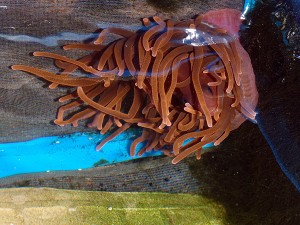
Yup, that's the "spare", smallest of 3 Sumatran Fire Clownfish (Amphiprion ephippium) living in a breeder net. The larger 2 have free roam of the same tank.
So yeah, those Pink Skunks. Birthday present from my inlaws from the Diver’s Den on LiveAquaria.com. I had sold the Ocellaris pair that lived in this reef prior, so I knew I had a spot for clowns and they wanted to get me some “nice” clownfish. Long story short, the reef also houses a pair of Starkii Damselfish (Chysiptera starkii) and I wasn’t sure how these new additions would be treated. I also wanted to give them an anemone, but was concerned about the Dragonette Pairs in this tank becoming “lunch” for the anemone. So I threw them in the breeder net with a Red Bubble Tip Anemone Clone. Eventually, one got out more than once and honestly the seemed OK. So I pushed the net down so that the edge sits maybe 0.5 to 0.75 inches below the surface. Well, turns out the clowns (as well as the Cleaner Wrasse (Labroides dimidatus) and Harlequin Filefish (Oxymonacanthus longirostris)) have figured out that they can come and go from the basket as they please. By night, the anemone and the clowns reside in the basket, and during they day they basically “overflow” into the tank at large. It honestly works so well for them that I hate to make changes to it.
And thus, because it’s worked well before, I hope / assume it can work well again, even if only an interim measure (I have NO desire to keep the Lightning Maroon alone in a breeder basket for any longer than I have to!). So, I’ll end this evening with 2 shots of the Lightning Maroon in acclimation and an interesting observation. When this fish stresses out, the white lightning stripes become tinged gray. You can kinda see it even in these pictures.
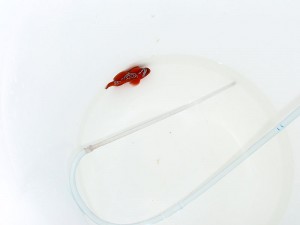
The Lightning Maroon Clown, Premnas biaculeatus "PNG Lightning", being drip acclimated from hyposalinity to full strength saltwater.
Tomorrow I’ll figure out what the heck I’m doing with the female PNG Maroon. Admittedly, I have an idea…
Yes, it is official. With my helping hand, the Lightning Maroon is bolting from QT / Hospital and into a breeder net. Not ideal, but I happen to agree with the advisers that the pros and cons of staying on my current course dictated a change.
Here’s the arguments for keeping the Lightning Maroon WITH the female, in hyposalinity.
- If the Lightning is still a male (I believe he is) then having the larger female puts social pressure on him to STAY male.
- well…that’s just it…that’s really the only direct “benefit” to keeping him in QT with the female. That was the main reason they went into a dedicated healthy tank together, divided only for their own safety.
On the flipside, the cons are much greater.
- Continued contact with the female may result in an otherwise healthy Lightning Maroon getting sick.
- If in fact the Lightning is more a “subordinate female” at this point, then the continued slightly antagonistic interactions I’m seeing are only going to get worse.
- Leaving the fish in this hospital / qt situation at hypo may at this point be putting undue stress on an otherwise healthy fish
There are of course, RISKS associated with moving the fish. The risks are actually quite substantial, but I believe I can sum it up like this. People are more afraid of what they know than what they don’t know.
- Moving the fish from QT to an established tank presents stress with a rapid rising salinity change. Honestly, this was my biggest fear, regardless of what Joe Lichtenbert told me and regardless of the real rationalizations I made earlier this week. It still scares the crap out of me to take a fish and double the salinity on it. Well, I did just that earlier today on the 4 remaining fish in the OTHER QT system, and they are all alive and eating this evening. Not saying that I condone this treatment in any way, only saying that experiences of multiple people are showing that a rapid salinity change in EITHER direction may not be as life-risking as we might normally be lead to believe. That doesn’t excuse folks to just dump fish willy nilly as the consequences results could certainly be different (i.e. dead fish). I can only say I am much more comfortable with the notion of doing this to a fish like the Lightning Maroon having first hand direct positive results in hand.
- Moving the fish into an existing tank means it’s going in a breeder net. Yes, that’s the case. All my well established reefs have pairs of clowns in them already. Adding the Maroon Clown directly to the tank would be beyond disruptive and life-threatening for all the parties involved. So a breeder net is the only viable solution (unless I stole a grow out tank, which I DID think about). Ultimately, the reality is that I have multiple clownfish happily inhabiting breeder nets, and in fact, I think my Vanuatu Pink Skunks PREFER having it (but they can come and go now as they please). At any rate, the biggest risk is that the fish gets OUT of the breeder net. I’ve had this happen, and the results were a shredded clownfish (that has since recovered well back in its net). I’ll be doing whatever I can to prevent an escape.
- Moving the Lightning Maroon could introduce one or more diseases, including the Fin Rot and Cryptocaryon, to the destination tank. This is a very real concern. The rationalization goes something like this. The Lightning Maroon is outwardly healthy and happy. So it is not likely directly diseased at this point. The fish has been in treatment with Maracyn for 24 hours now, and that seems to have kept the Fin Rot at bay. So it’s unlikely that would be transferred in as it’s not outwardly apparent on the Lighting Maroon. There is a second part, the “what if”? Well, IF this move causes a disease outbreak, first it’s important to consider that compared to the Lightning Maroon, every other fish in the destination tank is quite readily replaceable. Yes, harsh to say the least, but the Lightning Maroon has to take precedence over the other fish. It will be going into my SPS tank, which houses my most common broodstock. Now, that said, I’m not that worried about ICH. I may do a quick FW dip after acclimation is complete, one final “quick clean” before going in. Might not. Hard to say. Need to research that concept. Even if I don’t, honestly, I’m more worried about the Fin Rot. Well…the FIN ROT can be treated IN THE REEF with Maracyn SW. Yes, I am quite happy to say that Maracyn SW has proven itself to be quite reef safe. It just makes your skimmer foam like mad (which drives people crazy). But it doesn’t seem to kill your corals and inverts. So, if push comes to shove, I could treat the destination reef with Maracyn SW. Heck, I might even do so prophalactically. But again…I don’t know yet. I have to mull that over. More likely I’ll just keep a very watchful eye on things.
So ultimately, the decision was made this afternoon and plans were put in motion. As I mentioned, there were other options. One consisted of removing the Female to another tank, possibly the growout tank I’ve been using for some Black Ocellaris batches. Honestly, there’s 5 left, they don’t need a 10 gallon to themselves. I MAY still do this. The other possibility was already mentioned, moving the Lightning Maroon to this growout tank. Honestly, I don’t like the tank’s stability as much as I like my reefs. So when it came to my reefs, the only one I was willing to risk was the SPS tank…the other reefs have broodstock far more difficult to replace. Early on, I did even suggest stealing the 6 gallon nano from my Black Ocellaris pair, but honestly, if I don’t NEED to do that, I’m not going to. But I’m certainly taking a cue from them and thinking long term about a dedicated clown + nem tank for the Lightning Maroon and its mate.
Going on some earlier suggestions, I lined up one of my RBTA clones (Red Bubble Tip Anemone) as well as 2 rather brown specimens from Underground Aquatics (thanks for the steal of a deal Jim). The clown will not go into an empty breeder net, but one with a tile on the bttom as well as hosts. The clown will have 3 small Bubble Tip Anemones (Entacmaea quadricolor) to host in – that way the clownfish won’t totally annoy any single specimen hopefully. I should also mention that Bubble Tips are the only natural host for Maroon Anemonefish (Premnas biaculeatus). I already acclimated the 2 from Jim’s place and they’re lookin’ good under the HQI lighting – hopefully I won’t bleach ’em out.
I must admit, this is NOT a victory in my book, but a defeat. This is a retreat to safety. It does make me feel as if I’ve given up confidence on the female Maroon as well, even though I haven’t. But I will be making a few more adjustments this evening yet. Pictures in the next update…acclimation is already underway. Officially, by my refractometer, we are going from 1.012 / 16 ppt to 1.025 / 33 ppt. It’s being done on a slow drip.
As promised, I was never naive enough to take on this project alone, even with my “maverick”, “rule breaking” reputation. If I look at all my correspondence objectively with the advisers, I’d have to draw a general conclusion that the “fin rot” may have been the tipping point. Yes, there was certainly some underriding concerns about keeping the fish in the same tank together all along, but now, a new concensus (“bandwagon”) seems to have coalesced. With their permission, here’s what some of the advisers have said.
“At this point, I would advise getting the lightning maroon out of there and keeping it away from the female. From the pictures, that female is not doing well. The last thing we want is for any infections to be transmitted to the lightning. If the female gets better, you can reintroduce them but for now, get the lightning the heck out of there.”
– Mark Martin, Blue Zoo Aquatics
“When I quarantine new fish everything is kept separate just in case something like this happens. With the value and rarity of the lightning clown you simply can’t risk having it in the same system with a sick fish. I don’t know if putting it in your sps tank is a good idea though as you will have no options left for treatment. I would really try to separate that fish.”
– Dustin Dorton, ORA
“Get the male the hell out of here if you want to keep him alive, if you have a reef tank put it in it or any other well established tank, that fish is way to valuable to lose. I say it like it is you can keep trying to save the female if you wish, I know you want to keep the PNG lineage but getting another female later won’t be impossible, if you lose the male I’m guessing the project is done.”
– Edgar Diaz, Addy Zone
“I’m surprised you still have them together, Matt, I’d be very nervous, and I don’t see any benefit to having them together. They’ll’ bond plenty when they’re not feeling like crap.”
– Christine Williams
Certainly a lot to think about, and the majority at this point IS suggesting to remove the Lightning Maroon from the female (and I infer, this QT / Quarantine / Hospital tank).
Yes, I did an emergency big water change, over half the tank’s running volumes. Took out 10 gallons. Why?
Well…turns out when I set up this stand of tanks, I set it up in front of a closet in the rental’s basement. Didn’t think anything of blocking the closet…we’re not using it. Well..turns out our main water shutoff is in that closet. So when the plumber showed up today to fix some plumbing issues in the rental house, guess what he needed to turn off 😉
So..drain drain drain drain drain drain drain. Slowly move the 2 tanks on the stand across the concrete floor just enough to open the closet and narrowly reach in to turn off the valve. Then fill fill fill fill fill. But I DIDN’T think to save any of the water I was draining.
I had water mixing up already for a regular full strength water change, but I used that to quickly add some water to the top QT tank which was running with only an inch or so. Testing out Joe Lichtenbert’s observation that fish can handle rapid salinity changes in BOTH directions.
I got another bucket mixing at full strength, and decided I would use water from an existing tank to refill the Maroon’s QT tank. So….5 gallons out of the SPS tank, mixed with 5 gallons of dechlorinated tap water and in it went. Honestly, the fish seemed to like it, and it was the clearest I’ve seen this QT tank in a while now. I don’t know where the salinity is, but I suspect it’s up a little bit more now, maybe 1.012 or 1.013. I’ll have to check it later. When I tested it last night, it was around 1.011, and I added maybe a half gallon of distilled water to bring it back to 1.010-ish.
The interesting part, and why I say the fish seemed to like the water change, is that the female seemed to perk up rather quickly and started snapping at bits of food in the water as it swirled around. At least that’s what I think I was seeing. I can say with certainty that the fin rot has not progressed since last night. Her appetite remains iffy, and she does seem at times to be blind.
Since I drained probably 2/3 of the water, I felt obligated to hit the tank with a fresh pouch of Maracyn SW. So now I’m back on a morning dosing routine, which is not really where I wanted to be. (It’s easier to feed all day, do a water change in the evening, and then dose after the water change. Now, if I do a water change in the evening, I’m diluting overnight).
Anyway, that’s the 411 for this morning!
Well, water change, dosage of Fish Protector and Kent’s Vitamin C. Removal of GAC already. Turned off the BULB on the UV but not the flow – not sure if I can run UV while using Maracyn SW. Dosed with Maracyn SW. The only products carried by my local Petco are “Lifeguard” and “Maroxy”. Maracyn has been solid against this exact malady in the past when applied quickly (have seen this exactly same Fin Rot like this rampage through my Dragonette broodstock a few years back..it wasn’t pretty). I should also mention that Maracyn SW is noted as a valid treatment for fin rot. Anyone know the MARDEL company website? I want to email them some questions but I can’t even seem to find a good solid contact for them.
Let’s hope this at least stalls things. I am contemplating sequestering the Lightning Maroon back behind an eggcrate wall again – Dustin Dorton from ORA asked me about that as well this evening. And once again, thinking about removing the Lightning Maroon from this tank…he remains a typical healthy Maroon Clown. There is legitimate concern that leaving him in with her could cause more harm than good. Of course, I don’t like my options for alternate homes, and there is also the concern that removing him from her would cause him to become a her…
It’s funny how this all has taken precedence over any concerns about the known ongoing low-level issues with Cryptocaryon (ICH). I’m still debating whether I should push back down to 1.010 or even 1.009 as Joe Lichtenbert has suggested. I should point out that the better sources on Hyposalinity treatments do agree that the difference between 1.009 and even 1.010 might make the difference between successful treatment or not. Of course, you’re riding a fine line at 1.009 where fish death is a real possiblity (if you’re refractometer is even only slightly off).
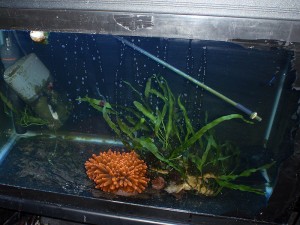
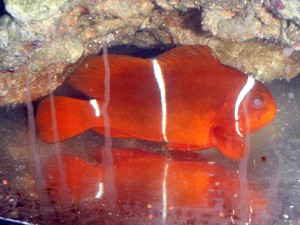
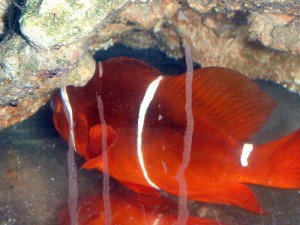

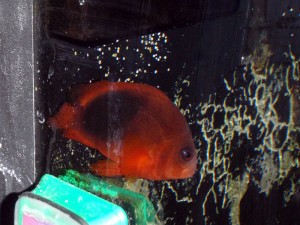


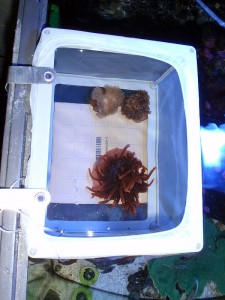

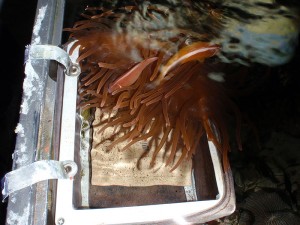
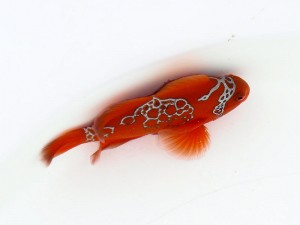
Recent Comments